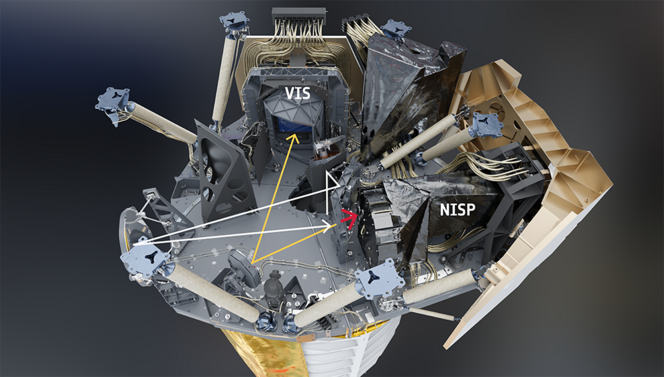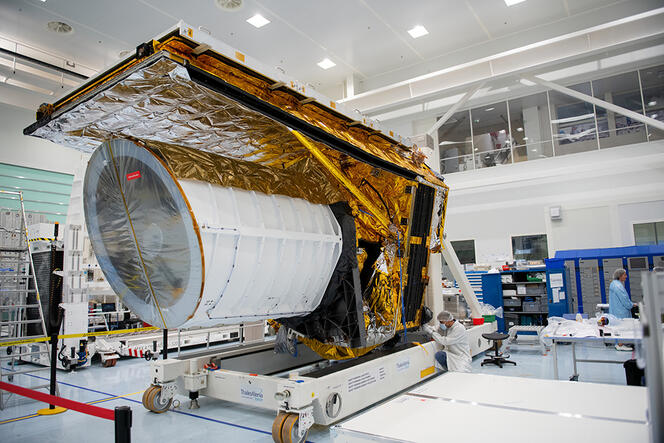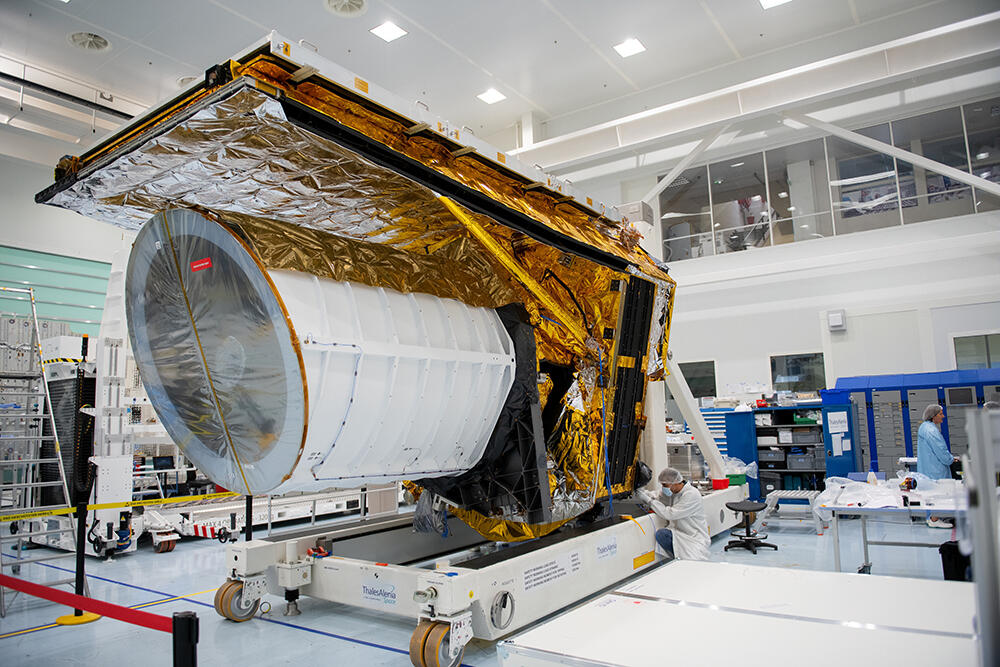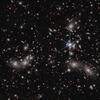You are here
Euclid on a quest to understand dark energy

Shortly after 5:00pm CEST on Saturday 1 July 2023, the European Space Agency's (ESA) Euclid spacecraft lifted off from Cape Canaveral, Florida (US), on a SpaceX Falcon 9 launch vehicle, heading towards its observation orbit 1.5 million kilometres from Earth. For the approximately 1,500 researchers, engineers and technicians involved in this extraordinary scientific venture, which has been over ten years in the making, the launch marks the beginning of the operational phase. “We're all very excited, this is a truly incredible moment,” says Stéphanie Escoffier1, who heads Euclid-France. The mission's goal is to scrutinise some two billion galaxies over the next six years, with the aim of drawing up the first 3D map of the cosmos out to a distance of 10 billion light years. The hope is to determine exactly what is causing the expansion of the Universe to accelerate – a fact that, for want of a better explanation, scientists attribute to a mysterious phenomenon dubbed “dark energy”, about which they understand absolutely nothing.
Accelerating expansion
Dark energy has fascinated the world of cosmology ever since 1998. At the time, two independent teams were wondering whether the Universe, under the effect of gravity, would see its expansion slow down indefinitely, or whether it would eventually experience a phase of contraction that would bring it back to its original state. Yet to everyone's amazement, the astrophysicists concluded that expansion had in fact entered a phase of acceleration which no one could explain.
However, repeated observations pointed to an unavoidable conclusion: it was as if the Universe were filled with a type of energy of unknown nature that, by opposing gravity, was causing it to expand ever faster.
According to the data, this energy, whose indirectly inferred properties bear no resemblance to any known matter, is even thought to account for some 70% of the total energy content of the Universe. The problem is that scientists have no idea what it is. Dark energy is invisible, elusive, and impossible to observe directly or capture on the sensitive surface of a detector.
On the other hand, its effects on the large-scale organisation of matter in the Universe can be observed, and its properties inferred, just as the morphological characteristics of a suspect can be deduced from their footprints.
Cosmic web and plumes of dark matter
Practically speaking, there are various ways in which the nature of dark energy might be pinned down. One approach is to map, on cosmic scales, the way in which galaxies organise themselves into long filaments, forming what specialists call the “cosmic web”. Another is to determine the structure of the plumes of dark matter, the invisible and still unknown component of matter in which galactic matter is immersed. “Today, the most precise surveys, covering several tens of millions of galaxies, can constrain the properties of dark energy to within 10%, which is not enough to determine its nature,” explains Yannick Mellier2, head of the Euclid Consortium, which brings together all the scientists involved in the mission. “To achieve this, we need to aim for a precision of 1%. That's the goal and, to succeed, Euclid will have to observe over 1.5 billion galaxies.”
Even though the ESA only classifies Euclid as a “medium-sized” mission, it is actually a space observation programme that is unprecedented in terms of its scale and technical sophistication. Indeed, the telescope will only achieve its goal, which is to create a great map of the large-scale structure of the Universe across space and time, if it successfully observes all the 40,000 points in the sky from which it will then produce around a million images covering more than a third of the sky, namely the part that is not “polluted” by the light from our own Galaxy.
To do this, the equipment on board the satellite was designed to meet extremely stringent specifications, and required the work of about a hundred laboratories, as well as industrial partners, from fourteen European countries plus the United States, Canada and Japan. Euclid is first and foremost a telescope of unrivalled stability, with a silicon carbide structure that is unaffected by temperature differences but at the same time brittle and difficult to manufacture.
Its 1.2-metre mirror is the most precise ever polished for its size, with a precision of 20 nanometres on its wave surface.
Two billion galaxies in view
Two additional instruments have been positioned at the focus of the telescope. The first is NISP, the largest infrared detector ever sent into space. NISP is a spectrophotometer designed to determine the distance of 2 billion galaxies. Of these, 30 million will be measured with the highest precision on the basis of their light spectrum, while the light from the others will be observed through different filters. NISP, which is also made of silicon carbide, has a focal plane with detectors whose detection quality is only limited by quantum noise. In addition, the lenses that focus the precious photons are the largest ever developed for use in space astrophysics. And finally, its grisms , the optical components that diffract the light from galaxies, were produced using a process that, astonishingly, had not even been invented when the project started.



The other instrument, VIS, is an imager with the same resolution as the Hubble Space Telescope but with a field of view 150 times greater. Its focal plane, measuring 40 cm x 40 cm, is made up of 600 million pixels arranged on a surface with variations of no more than 70 micrometres, and is the second largest ever sent into space, while its sensitivity is 20% higher than that of the best ground-based instruments. These specifications will allow VIS to photograph 1.5 billion galaxies and their deformations, which are caused by a gravitational lens effect. Statistical methods will then be used to determine the distribution of dark matter between the galaxies and the Earth. As Escoffier puts it, “having two instruments of such quality on the same spacecraft is absolutely unprecedented”.
Biggest-ever catalogue of space objects
Another first is Euclid's data processing chain. This will be tasked with retrieving the raw data sent daily from the spacecraft, cleansing it, correcting the various biases, extracting the relevant signals, adding information collected by ground-based observatories, determining the distances of the galaxies and calculating their deformation, all this with the aim of producing the largest-ever catalogue of astrophysical objects. This mine of information should then enable cosmologists to work out the properties of dark energy, boiled down to a handful of parameters. Carrying out these calculations will require the production of 150 petabytes of scientific data – a first in astrophysics – and the setting up of computing infrastructure involving nine data processing centres around the world.



Once Euclid arrives at its operational orbit, it will first spend several weeks testing its instruments, before making its “first light” observations in the autumn, and finally beginning its monitoring programme in December. The mission, which is scheduled to last six years, will see its findings published on three occasions, in 2025 on the basis of 20% of the data, in 2027 after analysis of half of the material collected, and finally in 2030 for the totality of the observations. In the meantime, all the available intelligence will have been analysed several times so as to take advantage of the improved software resulting from advances in artificial intelligence, which now plays an essential role in astrophysics.
Explaining dark energy
So, what will eventually come out of all this? According to some theoretical scenarios, dark energy may turn out to be a new form of matter. It could possibly be related to the Higgs field, discovered in 2012 at CERN’s particle accelerator, the LHC, and which gives all the fundamental particles in the Universe their mass. Or it might be linked to the inflaton, a theoretical particle that may have caused the cosmos to undergo exponential expansion in the very first fractions of a second of its existence. Others believe that dark energy could also be explained by challenging the general theory of relativity, which acts as a conceptual framework to describe the evolution of the Universe.
Then again, according to another hypothesis, dark energy might be no more than the vacuum energy posited by quantum theory, according to which even the most perfect vacuum is seething with so-called “virtual” particles popping in and out of existence. The problem with this idea, however, is that the estimated value of vacuum energy based on the known characteristics of the acceleration of expansion is totally inconsistent with that calculated using quantum mechanics.
Yet one thing is certain: “Although we have no idea what we're going to find, Euclid could totally revolutionise our understanding of the laws governing the Universe,” Mellier says. Prior to the launch, the entire community of astrophysicists and cosmologists were on tenterhooks, their eyes riveted on the Falcon 9 rocket ready to blast off from the launch pad. But with Euclid safely on its way to its operational orbit, their minds can now turn to the dizzying prospect of a complete upheaval in our understanding of the Universe. ♦
On 1 July, our scientists provided a live commentary on the launch of the Euclid spacecraft.












